It is interesting to see games contaminating each other, even across different genres. At times, it feels an equivalent of a cinematic universe. Like “What if someone makes a turn-based RPG but with DOOM?” But that’s a different game. Instead, how about a 90s FPS-like narrative but with turn-based action and RPG elements? Well, this is what Jupiter Hell is here to give us. Let’s rip and tear through it.
I’M ALL OUT OF GUM
The developers sell the game as “Chess with shotguns”. Not a bad description all considered, though they forgot to bring hell into the picture. Here it’s the usual “abandoned space-station swarming with demons”, familiar to anyone who’s played a Doom title before. At the start of each run, we get to choose between classes like Marine or Scout, with only slight differences in abilities, leading to somewhat different play styles.
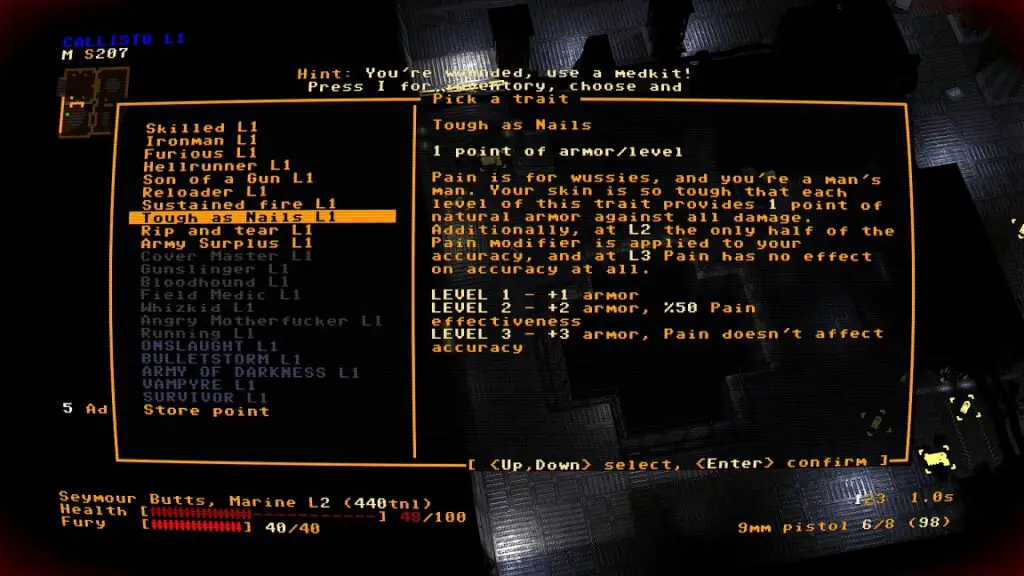
For what it says on the cover, Jupiter Hell does fine: recreating the Doom atmosphere of a run-and-gun shooter in a roguelike turn-based action game. Kill the enemies, gather the items, reach the elevator. Movement is possible in the cardinal directions, with simulated diagonals, requiring two turns. Weapons are easy to find, salvaged from dead enemies. They range from regular pistols to rifles and grenade launchers, as well as some melee variants.
While one can find some unique items here and there, the enemies mostly drop the same loot: ammo and weapons. Other useful things, like multitools, lie in special boxes, scattered throughout the levels. Terminals also play a role, quite like in the eternally underrated Doom 3. Though here, they don’t just provide story bits. Instead, the player can use these, via said multitools, to deactivate security drones or show parts of the map.
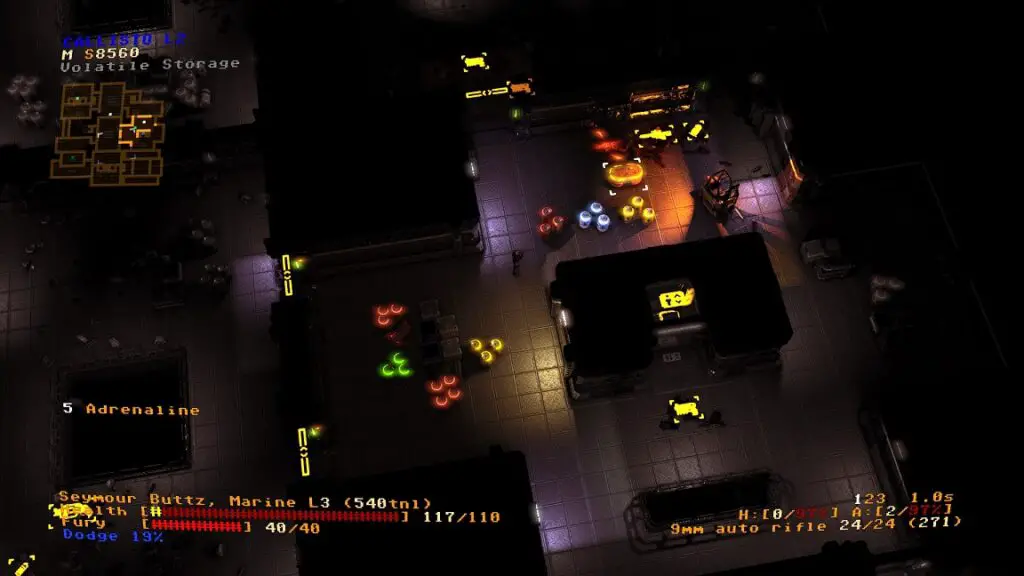
The interface can be entirely hit-and-miss. Personally, I love its incredible 80s faux CRT feel, but unfortunately, it’s not very intuitive. Sometimes, just figuring out some weapon’s damage may take a while. Sure, one could say it hearkens back to that authentic Rogue experience, but it’ll probably just turn off those looking for that action the game still provides.
GIVE ME SOME TURN BASED BABY
Jupiter Hell has been in development for several years at this point. It’s somewhat surprising since the game did not really feel like that to me. Sure, the amount of content is fine. Still, for a product that spent so much time in Early Access, one would expect something beyond its three classes and the same gameplay repeated ad nauseam with just different maps. While there are many variables, allowing for some replayability, the core of Jupiter Hell is always the same: kill demons, survive.
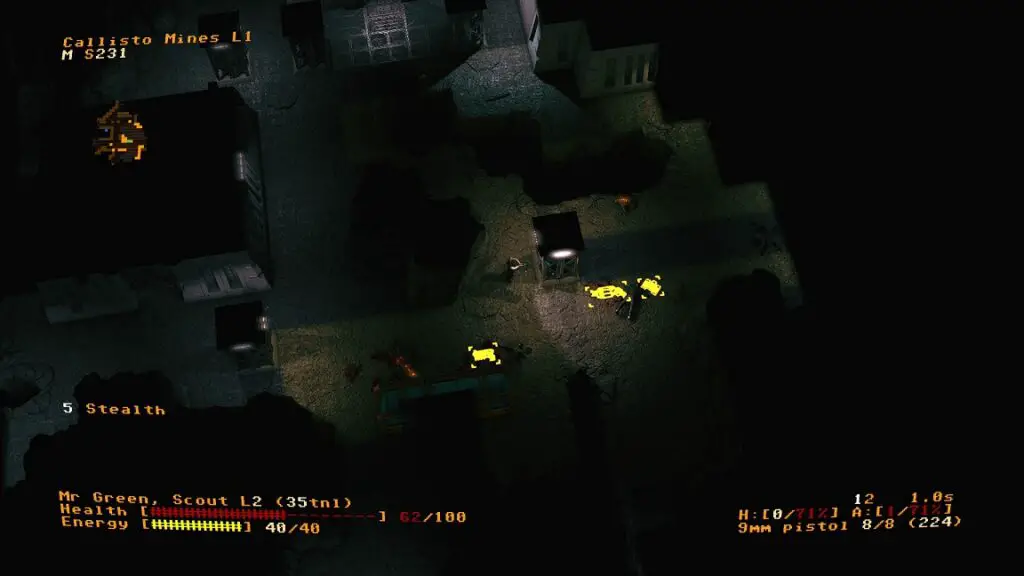
The RPG elements come into play mostly when levelling up. That’s when the player’s asked to decide whether to make a character who’ll rely more on some weapon or a higher armor class. While there is some variety, the choices are still quite limited.
Enemies constantly move around the level and are alerted by sound, soon coming to hunt down the player wherever they are. The cover system works fine, but using doors for this is quite cumbersome. They work completely automatically. Although the player can destroy them by shooting, this will just summon more enemies. As such, they can’t be employed in any strategic way.
COME GET SOME, GO LEAVE SOME
Here is the rub. The game wants to feel and play like Doom, while still being entirely developed from the ground up as an ASCII roguelike. This unfortunately leads to some problems in balancing the two different souls: the rip-and-tear with the strategic planning. It doesn’t feel as carefree as classics such as Take No Prisoners, but at the same time it cannot be played like an X-Com. The combat mostly involves walking around, waiting for the enemies to show up, running back to cover, and gunning them down. There doesn’t seem to be any more working strategies, other than that.
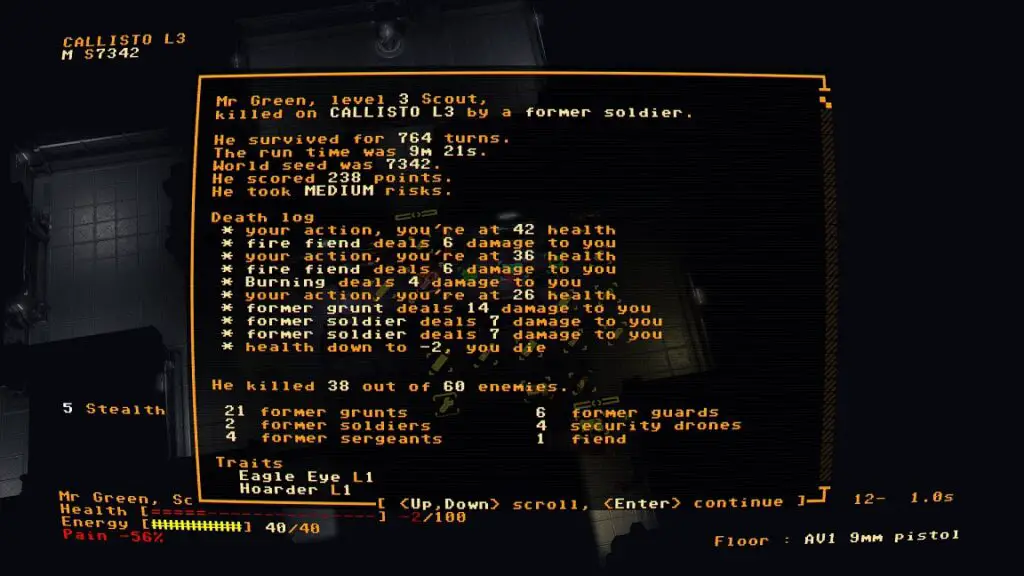
The times I have died, with quite a powerful character, were either because I walked into a group of 4-5 enemies without a decent cover, or a long corridor with no way of backtracking. After a few hours of playing, Jupiter Hell gets completely repetitive. Unless one is really a fan of ID Software or of foul-mouthed protagonists taken directly from the 90s. Speaking of that, at the start, the player must decide how much profanity will our character say. The weird thing is that even during long sessions, he seems to barely say anything.
Graphically, the game looks alright. Though with such a zoomed-out view, it’s almost impossible to make out the finer details. Thus, it all ends up looking a bit bland with its repetitive depiction of enemies and bases. I’d comment more on textures and enemies’ design, but zooming in any closer than the default results in losing sight of most enemies. There’s also no way to change it in real-time. The soundtrack is all chugging hard rock and metal, perfect for the Doom atmosphere. Though, again, it also seems to somehow end up contributing to the overall feeling that Jupiter Hell is a bit generic and bland.
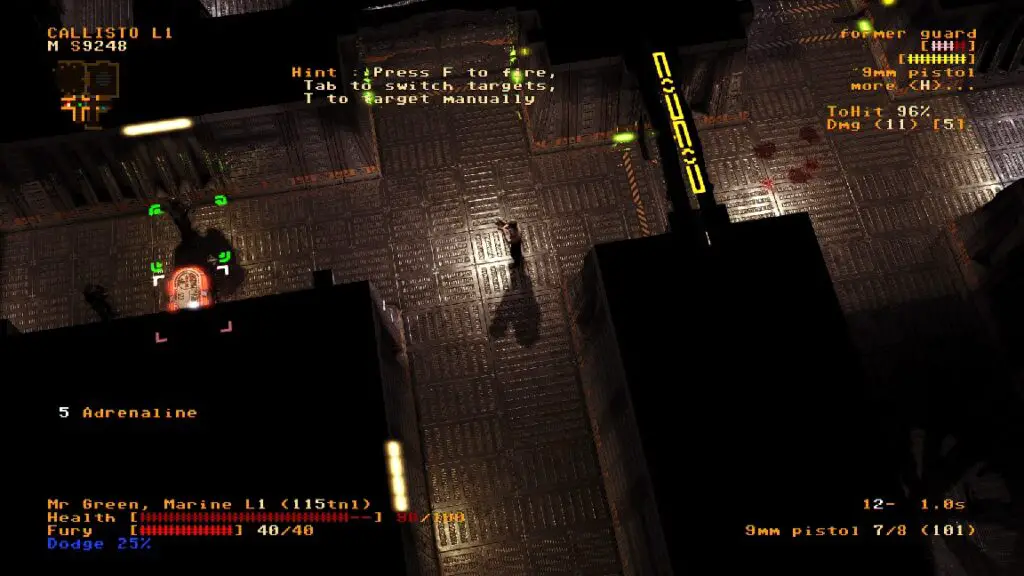


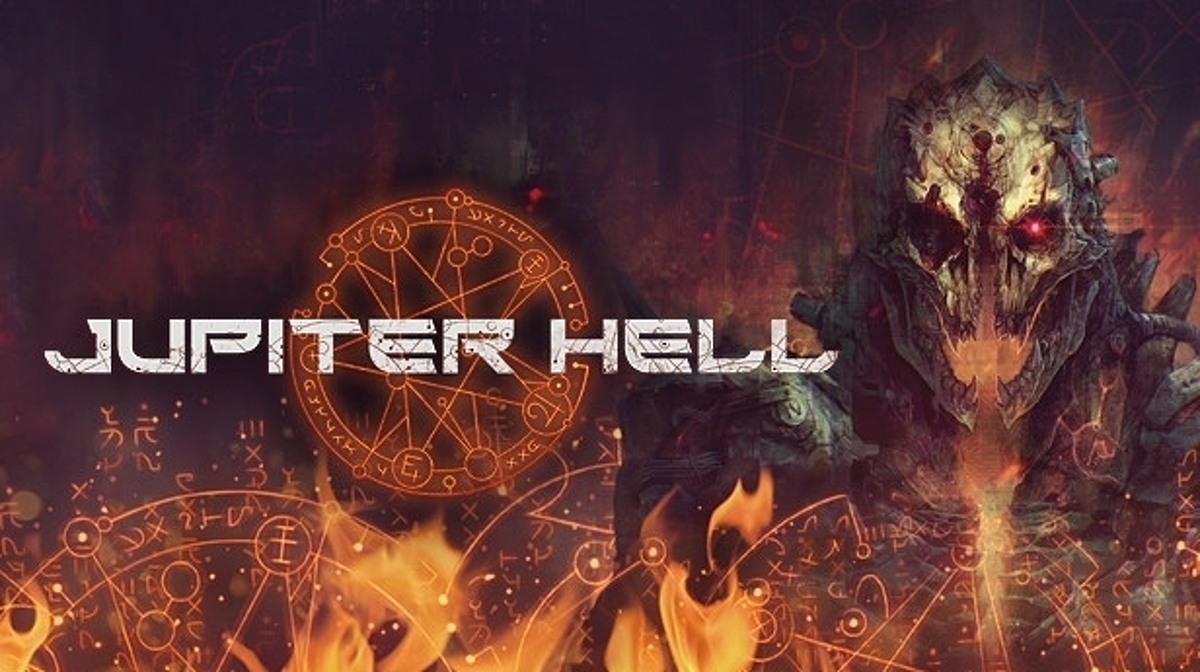







Way, WAY too low a score. 9.5, easy. One of my favorite games of the decade.
I usually don’t comment on reviews but there are significant complaints in this one that are factually untrue. I’d be curious to know the reviewer’s playtime prior to writing; many of these inaccuracies could probably be chalked up to the preconceptions of a newer player.
“we get to choose between classes like Marine or Scout, with only slight differences in abilities”
Even from the start, the three classes have very different abilities from each other. Marine has passive heal on level start and an active that heals and buffs. Scout can see main level elevators (the complete lack of mention of the branching paths system and how terminal quests tie into that are another complaint of this review) and has a stealth active. Technician uses consumables in half time and has active smokescreen and dismantling (another core component of the game that isn’t mentioned) abilities. Each class obtains the resource for their active abilities differently, further distinguishing them from each other even from the start of each game.
“just figuring out some weapon’s damage may take a while”
If you have trouble figuring out weapon damage I don’t know what to tell you. You can see the damage numbers, ranges, crit chance/damage, etc of each weapon before even picking it up. When targeting an enemy the hud displays damage, crit chance, and hit percentage. Look at the upper right of the last screenshot in this review; the hit display is rather intuitive. My only guess as to where the trouble came from is that the reviewer might’ve been confused by shotguns, where the %hit chance actually modifies weapon damage rather than hit chance because shotties always hit if the enemy is in range.
“one would expect something beyond its three classes and the same gameplay repeated ad nauseam”
Something such as trial modes that impact what weapons you can use, how much you can carry, or how far into a run you start. Or maybe something like challenges where you fight through an arena instead of the standard branching paths, or a mode with either all or none of the paths accessible. There’s frankly an impressive amount of game modes, but some of them only unlock when achieving certain thresholds in the main game. This is some of the reason I suspect the reviewer didn’t give JH a fair shake before writing. The frustrating part here is that I do actually agree with this complaint; in many ways the game can feel repetitive. You are always in the same fundamental gameplay loop of moving and shooting. Misrepresenting the available content doesn’t help prove that point though.
“That’s when the player’s asked to decide whether to make a character who’ll rely more on some weapon or a higher armor class.”
Many of the traits, especially in the most recent edition that the reviewer is playing, are weapon agnostic. There is no requirement to spend levels to wear heavier armor. Maybe this confusion came from the Marine’s Tough as Nails trait, which does grant one natural armor per level. However, this works nothing like DnD Armor Class, which is what it feels like this statement is implying. Traits do generally specialize along certain playstyles (there are traits to make running better, make waiting behind cover better, make it better to shoot multiple times in a row or move and shoot, etc) but not in the way that the reviewer states. There’s also no mention of Master traits, which are the more significantly gameplay-altering traits that you can only get one of and only level up at certain thresholds.
“Enemies constantly move around the level and are alerted by sound”
Some alert to sound, some to smell, some just to sight. This isn’t a big deal, I just find the different hunting methods of the enemies fun.
“using doors for this is quite cumbersome. They work completely automatically. Although the player can destroy them by shooting, this will just summon more enemies. As such, they can’t be employed in any strategic way.”
This is untrue. Some levels do have automatic doors that open on approach, but most doors are not automatic and can be manually opened and closed using the action button. Playing around doors is a viable strategy to bait and ambush enemies. Shooting doors doesn’t summon enemies.
“ASCII roguelike”
I’m not even sure what is meant by this. The screenshots prove it is not an ASCII game. It’s a roguelike on a grid but that doesn’t an ASCII roguelike make. Maybe the confusion comes from the same developers being behind DRL (Doom the Roguelike)?
“I walked into a group of 4-5 enemies without a decent cover, or a long corridor with no way of backtracking.”
I don’t want to sound like a git gud person but this isn’t something that’ll happen if you’re playing smartly. Enemies only move when you do; if you’re rushing through levels you can run into a cluster like this but if you look before moving you’ll see them and be able to plan what to do about it. If they’re around a blind corner then you have cover available – take the one step back behind the corner.
“even during long sessions, he seems to barely say anything”
I actually have the exact opposite complaint with the main character. It’s refreshing to not have a generic silent protagonist but sometimes he doesn’t shut up.
“with such a zoomed-out view, it’s almost impossible to make out the finer details…zooming in any closer than the default results in losing sight of most enemies”
This is a fascinating complaint. If there’s a game out there where I can make out the same detail while zoomed out as zoomed in and can see as far while zoomed in as zoomed out then please let me know.
A lot of why I took so long to review this review is because I actually fundamentally agree with a lot of it. I think it’s clear that I have a lot more love for the game than the reviewer, but he is correct in that Jupiter Hell suffers from feeling repetitive and bland at times. The branching paths, terminal quests, and relatively long playtime per run when compared to other roguelikes help alleviate this a little but it can start to feel like a chore to play. This is especially true if you’re dying more than you’re winning; in its current state the first moon is easily the least interesting part of the game. Luckily, the developers are still releasing major updates and have stated that making the first moon more interesting will be the goal of next update. I’d encourage the reviewer to give Jupiter Hell a little bit more time. It’s not a game that you’d want to play for hours on end, but nothing scratches the same sort of badass turn-based cover shooter itch.
First thing first. Sorry for the delay in approving your comment. It was an enjoyable read and I think you brought up some fair points. That said. While I’m not Damien and wont defends his opinion about the game, I will back his rating. I was given a key many years ago. Can’t remember if it was from GOG or the developer himself. Whoever it was I’ve been playing the game on and off since.
Now, I’m no fan of arbitrary numbers myself. But if I had to give Jupiter Hell a rating I’d give it 7.6, which isn’t to far off from Damiens 7. Like you’ve said yourself. While Jupiter Hell is a good game it can become a bit repetitive after a while. That in itself doesn’t have to be a bad thing if you’re looking for that type of game or gameplay. The problem is that the word “repetitive” has a negative connotation. And most people treat it as such as well.
I think more people should do what you did and focus on the details rather than arbitrary numbers. That is after all what other gamers can learn from and base their purchases on!
Thanks for the very in-depth comment, I wish I had the time to go point by point, but I will just point out a couple of finer details.
The “ASCII roguelike” was something that the developers themselves said in a comment on Steam, about why they could not modify some things about the engine: “underneath this [game] is a traditional ASCII roguelike game – we cannot tie visual effects to game mechanics, otherwise we lose ASCII compatibility.” So I mean, I trust they know what they’re talking about!
As for doors opening with an action button, this actually goes against what the tutorial itself said, which I’m slightly perplexed about since someone also mentioned the mousewheel+shift to scroll, again not mentioned even in the controls. There are several reviews which also mention the automatic door opening, so is it something that was added later but not throughly explained in the tutorial I wonder?
Finally, about the zoomed-out view, there are many instances of interfaces that still clearly communicate to the player when enemies are in sight but out of view by using indicators or arrows.
– Damiano
I feel like the game would do well to mention the shift+mousewheel zoom function. 🙂
Thanks for the review. I’ve played quite a lot of jupiter hell, and for my experience I found a great deal of emergent depth. I very often compare it to xcom, particularly regarding the way cover, aiming, hunkering etc create dynamic decision making.
I *can* see the potential to experience something repetitive in the gameplay loop, but I found no sense of repetition provided the difficulty was set high enough to necessitate clever decision making. I guess what I mean by this is that the game has an excellent balance when it comes to which tactics lead to success, encouraging varied play and on-the-fly decision making that changes well with the random elements of the seed (weapons, enemies, armour, and layout). Sadly, though, this kind of deep decision making probably isn’t immediately apparent, and not even present when playing at difficulty levels ‘too low’ for a player’s skill set.
Regarding the example given in the review (death results from entering an ambush in unfavourable cover), I’d offer that as a player learns and improves, that is one situation they learn to avoid, at which point many other, new challenges present themselves. It’s this emergent depth that made me feel I was experiencing variety in the gameplay.
All that said, I’m only trying to shed some light on the experiences that jupiter hell can offer with more time invested. For the (assumingly limited) time spent before writing the review, I can see how the conclusions were drawn.
Again, thanks for the article! I hope you get a chance to uncover more layers of the game, but I understand that a reviewer can’t always invest hundreds of hours in every title!